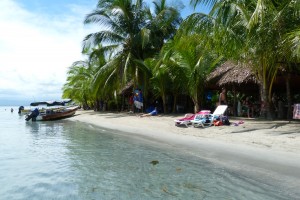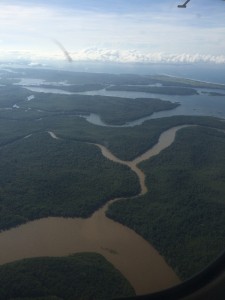By Alastair Smith, Panama
Following exploratory fieldwork in the rural coca growing fields of Colombia, GDPO followed the cocaine supply chain to Panama. Most recently, time spent on the Northern Caribbean coast soon revealed the permeation of drug trafficking into the already complex socioeconomic context that many perceive as paradise.
First impressions of Bocas del Toro – the name of both the 7,000+ person settlement on Isla Colon, just off the north eastern seaboard of Panama, but also the wider surrounding Province – largely confirm its international reputation as an accessible tropical ‘paradise’. With sympathetic afternoon light, the final leg of the 1-hour flight from Panama City reveals aqua marine water lapping at golden sands backed by lush green forests. Once established in the area, other widely talked about attractions of Bocas quickly emerge. There is a wealth of outdoor activities. Many international tourists, largely backpackers, and domestic visitors come to enjoy the Caribbean Sea: to scuba dive and snorkel, surf the notorious waves of Playa Bluff, or to take things a little easier with sunbathing and guided tours to spot the charismatic wildlife.
Another attraction of Bocas del Toro for many, and particularly backpackers, is undoubtedly the opportunity to mix Salsa and Reggaeton music, with low cost national beers and regional rum cocktails, as they enjoy the party life offer on Isla Colon (primarily in BocasTown) and the surround islands. Many of the bars and clubs in Bocas town are right on the water: making it very possible to ‘live the dream’ of enjoying beers in a hammock, dancing off the alcohol, and when things get a little too hot back-flipping off the dock into the cooling sea.
In this hedonistic environment, it is seemingly easy to forget the volumes of boat traffic and not think about the dubious quality of the sea water while enjoying a midnight swim. Another undercurrent in the town is the availability cocaine and cannabis. Sellers freely mix in the nightlife with various degrees of subtly in communicating their offerings. During the day, it is unusual to walk the length of town without being offered ‘weed’ – sometimes as a follow up to the initial list proposal of taking a boat tours to the beach – although there is little menacing about time spent in Bocas, and disinterest is well-accepted by opportunistic sellers.
Part of the reason for the level of supply is the demand of international tourists and more permanent life style migrants willing to pay higher prices than local consumers. However, Bocas del Toro is also well supplied with drugs as one of the recognized points of refuge for traffickers making the journey up the EasternCoast from Colombia to North America
Originally founded as a settlement of concentrated population by foreign banana producers, the region remained disconnected from administration in Panama City due to a lack of a reliable road connection: and therefore, the centralized government administration has lacked a presence in many respects. The archipelago is also composed of some highly remote islands that fall well beyond almost all government services and authority: and as in many cases across the world, the lack of state institutions supports the trafficking of drugs.
Despite limited resources, local law enforcement officers in Bocas confirm that they have been involved in interdiction operations in partnership with central authorities and the US Coast Guard: furthermore, these operations have yielded high powerboats used by the traffickers that are then repurposed for local counter narcotics operations. Discussions with the local police support existing knowledge that traffickers use the inland water ways of the Panamanian coast to evade the authorities during the day, and then make their staged journeys under the cover of night (UNODC 2012). In some cases it is believed that small shipments of drugs are consolidated in Panama before being moved on (UNODC 2012). Local testimony also identified that during chases, traffickers will jettison quantities of drugs in attempts to bribe the police.
It is through a combination of these mechanisms that trafficked drugs enter the Bocas economy. The availability of drugs then provides relatively easy returns for those willing to become involved. This option is especially attractive so some due to the poor quality of education, high levels of poverty and general limitations on livelihood opportunities in the Bocas region. Despite Panama’s average national economic growth of 7.2% between 2001 and 2013, of the mainly indigenous population of the Bocas del Toro province, 25% are classified as poor and 11% as extremely poor (Omar and Moreno 2014). Many of these people live on subsistence agriculture and fishing on outer islands. There is therefore a potentially strong pull incentive to become involved in the distribution of drugs. In this case, as was found in Colombia, rural development will likely be as important an anti-trafficing policy as strengthening governance capacity for interdiction operations.
In conclusion, while the vast majority of visitors to Bocas del Toro find their expectations of fulfilled, the reality is that the international trafficking of drugs is playing into a complex socioeconomic situation, which many of the ‘poor’ permanent residents might well not accept as ‘paradise’. Again, genuine investment in enhancing the life opportunities of those currently motivated to support drugs distribution will likely contribute to a reduction in the global trade in narcotic drugs.
Sources
Omar, A. and V. Moreno ( 2014). Pobreza e Indigencia. Panama, Ministerio de Economia y Finanzas.
UNODC (2012). Cocaine from South America to the United States. Transnational Organized Crime in Central America and the Caribbean A Threat Assessment. Vienna, United Nation Office on Drugs and Crime.
Follow the Global Drug Policy Observatory:
GDPO on Twitter GDPO on Facebook GDPO on Academia.edu GDPO Website


